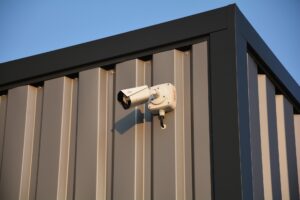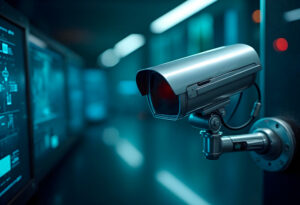Access control refers to the ability to manage, monitor, and restrict the movement of individuals, assets, or vehicles in and around a building or site. A Networked Access Control System allows the management of doors from a central point, often using a computer network.
Key Takeaways:
- Access control systems come in various types, including biometric, card-based, and keypad systems.
- These systems improve security by restricting entry to authorised personnel only.
- The choice of access control system should be based on the specific needs of your organisation, taking into account factors such as budget, level of security required, and ease of use.
- A well-implemented access control system enhances safety, reduces unauthorised access, and provides data for monitoring and auditing.
Different Types of Access Control Systems and Their Benefits
Access control systems come in various types, each designed to enhance security while offering unique advantages. Keycard and keypad entry systems are popular in commercial spaces for their ease of use and ability to restrict access. Biometric systems, such as fingerprint or facial recognition, provide a high level of security by verifying a person’s identity based on unique physical traits. RFID systems offer contactless access, ideal for high-traffic areas, while mobile-based access control allows users to gain entry via smartphones, increasing convenience. Cloud-based systems, which store data remotely, enable real-time monitoring and easy scalability for businesses with multiple locations. The benefits of these systems include improved security, the ability to track access activity, reduced reliance on traditional keys, and increased convenience for both users and administrators. These solutions provide flexibility, making them suitable for various environments, from small offices to large, multi-site organisations.
We consider this system ideal for educational sites, including schools, colleges, and universities. It enables easy management of single or multiple entry points from a single location. Such systems are particularly beneficial for medium to large sites, simplifying the management of numerous doors and users.
How do access control systems function?
Security and network access systems, including CCTV, have advanced significantly in recent years. Modern door readers are smart devices connected via the network, powered by Power over Ethernet (PoE). These readers store identification codes for everyone registered on the system and remain operational even when the main network is down, provided backup power is supplied to the network switch. Upon receiving an ID, the reader transmits it to the controller, which then verifies the ID. If accepted, the door unlocks.
The reader controls the electric door lock and powers it. These readers also feature sensors to detect if a door has been opened and allow a ‘Request to Exit’ (REX) function through a button.
Each access device, such as a card or fob, comes with a unique identification number. Users can choose from various formats, such as thin cards, thick cards, or key fobs. Every device has a distinct code for identification.
Biometric access control systems offer a further layer of security, using personal characteristics like fingerprints or facial recognition instead of carrying a physical card. This option, while more secure, may be cost-prohibitive for schools with limited budgets.
In emergencies, these systems are generally programmed to unlock automatically if:
- The fire alarm is activated
- There is a power failure
- A manual override is used
- The fire alarm system malfunctions
Types of Access Control
Schools often employ a mix of types of access control systems across different areas. In some sections, stricter control is needed, while other zones might not require stringent restrictions.
Access control systems comprise three key components:
First is the physical barrier, preventing unauthorised access. This may include doors secured by magnetic or strike locks, turnstiles, or speed gates, all designed to admit one person per authorised access. It’s essential to ensure a secure school perimeter, starting with access control at the boundary. A remote intercom and release system allow staff to verify a visitor’s identity before granting access to reception.
Next is the identification device, often networked, which confirms the user’s identity. Various devices are available, such as proximity cards using Radio Frequency Identification (RFID), smart cards, swipe cards, PIN pads, or biometric scanners like fingerprint readers. These can be utilised throughout the school to limit access to only staff and students, minimising the risk of unauthorised entry.
The final component is the door controller and accompanying software, which governs who can access specific areas and at what time. This varies according to the system’s size and the number of readers or sites being managed.
Schools generally combine several types of access control. Options range from standalone controllers for individual doors to fully networked systems covering multiple sites. Each system has advantages depending on the school’s specific needs.
Benefits of Networked Access Control Systems
The advantages of networked systems are clear. From a school’s perspective, the primary concern is ensuring the safety and security of students, staff, and equipment. A system that not only manages visitor access centrally but also offers real-time data and images is highly valuable.
Key benefits include:
- Preventing unauthorised access
- Managing entry and exit across various buildings
- Integration with CCTV
- Detailed access logs for investigating incidents like theft or vandalism
- Emergency lockdown features
- Flexibility and scalability
- Long-term cost efficiency
- Deterrence against crime
If your school’s current system needs an upgrade, contact us at 01702 4767002 to explore how we can assist. We’ll arrange a free survey and discuss the best types of access control for your specific needs.
Choosing the right types of access control for your business is crucial for enhancing security and controlling who has access to specific areas. At AI-Security, we offer tailored solutions to meet your specific needs, whether you require biometric, card-based, or keypad systems. Secure your premises and improve operational efficiency with a reliable access control system. Contact us today at 01702 476 700 or visit us at Vigilant House, 1155 London Road, Leigh-on-Sea, SS9 3JE, to discuss the best options for your business!
Conclusion
Understanding the different types of access control is crucial for enhancing the security of your facility, whether it’s a business, school, or residential complex. By carefully assessing your specific security needs, you can choose the most suitable access control system, whether it be physical, electronic, or biometric. Prioritising the right access control type ensures that you not only protect valuable assets but also create a safe and secure environment for everyone. Ready to boost your security? Explore professional access control solutions today and find the best fit for your needs!
FAQs:
Q: What are the most common types of access control systems?
A: The most common types of access control systems include biometric systems (fingerprint or facial recognition), card-based systems (RFID or keycards), and keypad systems (PIN-based entry).
Q: How do I choose the best access control system for my business?
A: Consider the level of security you need, the sise of your premises, your budget, and how easy the system is for your staff to use. You can also consult a professional for tailored advice.
Q: Are biometric access control systems more secure than card-based systems?
A: Yes, biometric systems tend to offer a higher level of security because they use unique biological data like fingerprints or facial recognition, which are harder to duplicate or steal compared to cards.
Q: Can access control systems track employee attendance?
A: Yes, many access control systems have integrated tracking features that can monitor employee attendance and entry/exit times, providing valuable data for audits.












